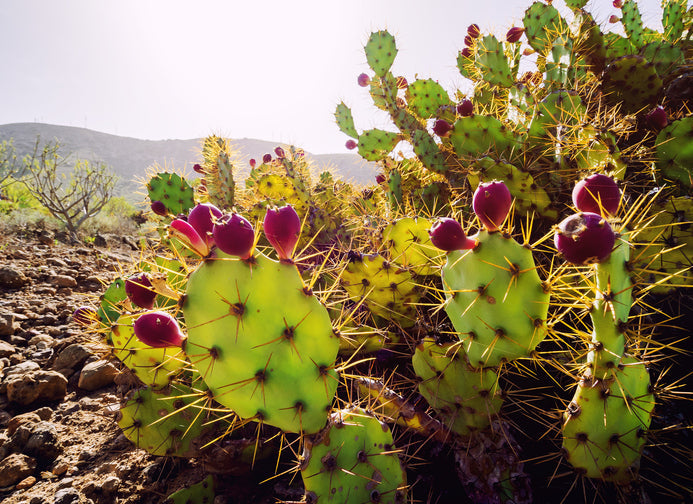Picture yourself strolling through a landscape bathed in sunlight, where rocky, paddle-shaped plants watch over you. A cactus, a spiky desert survivor, may be visible to you. But what if I told you that there is a culinary secret hidden inside those jagged green paddles? A vegetable that will add flavour and nutrients to your salads, tacos, and stews. It's time you became formally acquainted with the humble nopal, which is not a desert mirage. A world of knowledge is concealed behind this green treat's prickly exterior before you plunge fork first into it. Think of this as your official manual for maximising the amazing potential of one of the most misunderstood superfoods in nature.
What are Nopales?
The Opuntia cactus, also called the Prickly Pear cactus, has edible, fleshy, paddle-like leaves called Nopales. These cactus pads are considered a vegetable and have been a mainstay of Mexican and Central American cuisine for centuries. When cooked, they have a crisp yet tender texture and a flavour that is frequently likened to a zesty asparagus or a slightly tart green bean. The catch is that they can have a slimy, mucilaginous texture akin to okra if not prepared properly. But don't let that stop you! Their delicious flavour and firm bite can be unlocked with proper preparation, which makes them a flexible addition to many different recipes.
How to Prepare Nopales?
Preparing the Nopales is the most crucial step in using them in your cooking. It's the process that separates a tasty meal from a slimy mess. This is your comprehensive guide to becoming an expert in this desert vegetable.
1. Selection Start by choosing young, firm, bright green Nopales: They should feel adaptable without being slack. Smaller pads tend to be softer and have a milder flavour. Some farmers' markets, Latin American markets, and even larger supermarkets carry fresh ones. If you can't find them fresh, canned or jarred versions are great, pre-cleaned alternatives.
2. De-Spinning (The Important Step): Put safety first! The pads have two types of spines: large, visible ones and small, hair-like ones called glochids, which can be very annoying.
· Put on Gloves: To protect your hands, put on thick kitchen gloves or hold the paddle with a pair of tongs.
· Lay the nopal flat on a chopping board and scrape it without peeling. Scrape against the grain with a sharp knife held at a slight angle to remove the spiny nodes. They'll pop off right away. Be sure to scrape both sides and the edges.
· Rinse Well: After de-spinning, thoroughly rinse the Nopales under cold water to get rid of any last bits of glochids or spines.
3. De-Sliming (The Secret Step!): The viscous liquid (baba) inside Nopales may be disgusting to some people. Here are three popular methods for lowering it:
· Boiling: The most widely used method. Cut the Nopales into strips or squares and boil them for 15 to 20 minutes in water with a pinch of salt, some onion pieces, and cilantro to make them tender. Some traditional cooks swear by adding a copper coin or a few tomatillo husks to the water to help cut the slime.
· Grilling: Since the slime is mostly evaporated, Nopales cooked whole over high heat will have a smoky, perfectly tender texture. Just brush with a little oil and grill for 5 to 7 minutes on each side.
· Curing: Before using Nopales raw in salads, they can be cured. Chopped Nopales should be placed in a bowl and liberally sprinkled with coarse salt. Let them sit for thirty minutes. The salt will attract the slime. Rinse them well before using.
What are the Nutritional Benefits of Nopales?
Nopales' exceptionally high nutritional value makes them a worthy addition to any diet that prioritises health. This vegetable is low in calories and high in essential nutrients.
· Packed with Minerals and Vitamins: Nopales are a great source of vitamin C, an antioxidant that boosts immunity, vitamin K, which is essential for blood coagulation, and vitamin A, which is for healthy skin and eyes. They are also a good source of calcium, potassium, and magnesium.
· Packed with Dietary Fibre: The high fibre content promotes a feeling of fullness, aids in digestion, and keeps the gut healthy, all of which can help with weight management.
· Packed with Antioxidants: They are abundant in antioxidants, including polyphenols and flavonoids, which help the body fight off oxidative stress and inflammation.
· May Help Regulate Blood Sugar: Traditional Mexican medicine has long utilised Nopales to help regulate blood sugar. Because Nopales contain fibre and certain compounds that can slow the gut's absorption of sugar, they can help people with type 2 diabetes (under medical guidance, of course).
· Supports Heart Health: Fibre, potassium, and antioxidants may support heart health by helping to lower LDL ("bad") cholesterol levels and maintain normal blood pressure.
Are There Any Side Effects of Eating Nopales?
Serious side effects from eating Nopales are uncommon, but it's still a good idea to be aware of them. For most people, Nopales are a safe and nutritious food.
· Digestive Issues: Due to their high fibre content, Nopales may cause temporary gas, bloating, or diarrhoea while your digestive system adjusts.
· Hypoglycaemia Risk: Because Nopales can lower blood sugar, people on diabetes medication should talk to their doctor and keep a close eye on their blood sugar levels when eating them. The combined effect may cause hypoglycaemia, or abnormally low blood sugar.
· Spines: This is less of a side effect and more of a risk for preparation. If the mouth and throat are not properly cleaned, eating even the tiny glochids can cause irritation.
Nopales vs. Aloe Vera: Are They the Same?
Aloe vera and Nopales are not the same, even though they are both succulents with health advantages. They belong to different plant families and have different functions, despite the fact that they are commonly confused.
|
Feature |
Nopales (Prickly Pear) |
Aloe Vera |
|
Plant Family |
Cactaceae (Cactus family) |
Asphodelaceae (Liliaceae family cousin) |
|
Edible Parts |
The flat paddle (nopal) and the fruit (tuna) are commonly eaten. |
The inner gel is edible in small quantities; the outer leaf is a laxative. |
|
Primary Use |
Primarily used as a vegetable in cuisine (grilled, boiled, in tacos, etc.). |
Primarily used for its topical skin-soothing gel and in beverages. |
|
Flavour Profile |
Tart, citrusy, similar to green beans or asparagus. |
The inner gel is bland and can be slightly bitter. |
|
Appearance |
Large, flat, paddle-shaped leaves covered in spines. |
Long, thick, spear-like leaves with serrated edges radiating from a central base. |
The next time you pass that pile of green paddles in the produce section, you won't just see a spiky, scary cactus. On exhibit are a nutrient-dense powerhouse, a touch of authentic culinary tradition, and a versatile vegetable that can be used to add flair to your meals. With this knowledge, you can select, de-spine, and prepare them with skill.
Will you grill them whole for a smoky side dish? Chop them up for a vibrant Nopalito salad. Or make a hearty stew with them? You can choose. Embrace the paddle and venture beyond your comfort zone to uncover the delicious secret the desert has been keeping. More significant than merely trying a new dish is connecting with a rich history and a vibrant flavour that have been cherished for generations. You can give it a try. Your taste buds will enjoy it.

